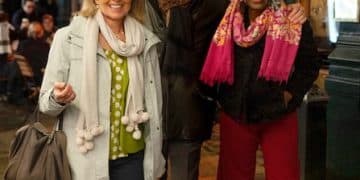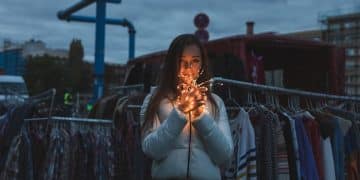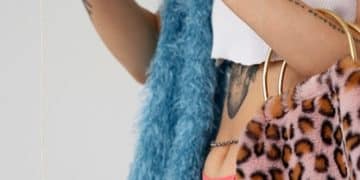Thrift Store Flipping: High-Fashion Looks Under $50
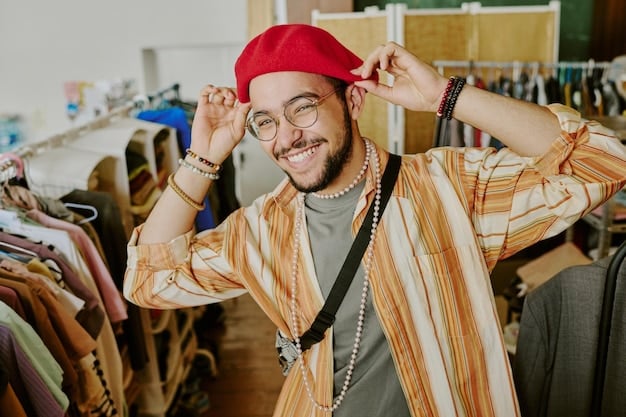
Thrift store flipping involves transforming secondhand clothes into high-fashion looks for under $50 by sourcing affordable pieces, creatively altering them, and styling them into unique outfits, offering a budget-friendly way to achieve high-end style.
Do you dream of high-fashion looks without the high-end price tag? Thrift store flipping: turn secondhand clothes into high-fashion looks for under $50 is your answer. It’s a creative, budget-friendly way to express your style.
Unlocking the Potential of Thrift Store Finds
Thrift stores are treasure troves waiting to be discovered. They’re filled with unique clothing items that, with a little creativity, can be transformed into stylish, high-fashion pieces. The key is to see the potential beyond the initial appearance.
Thrift store clothes offer an affordable and sustainable approach to fashion. The thrill of finding a hidden gem and reimagining its purpose is unmatched. It allows for creativity and unique style.
Identifying Quality Pieces
Before diving into the world of thrift flips, knowing what to look for is very important. It’s about more than just spotting something cheap. It requires having an eye for quality pieces that can be altered and repurposed to fit your vision.
Fabric and Construction
Examine the fabric for wear and tear. Look for sturdy seams and well-made construction. Ignoring minor damage can be a project, but avoid anything that compromises the integrity of the garment.
- Check for stains, tears, and excessive wear.
- Inspect buttons, zippers, and other fastenings.
- Prioritize natural fibers like cotton, linen, and wool for easy alteration and durability.
By carefully selecting quality pieces, you’re laying the foundation for a successful thrift flip project. This initial step ensures that the time and effort you invest will result in a valuable piece of clothing that you’ll be proud to wear.
Ultimately, a great piece for flipping starts with a sharp eye and an understanding of what makes a garment worth saving.
Essential Tools and Skills for Thrift Store Flipping
Turning secondhand clothes into high-fashion looks involves specific tools and a bit of skill. While sewing experience is beneficial, it’s not always essential, depending on the complexity of your projects.
The right tools can make the process smoother and more enjoyable. The necessary skills can be learned through practice and online tutorials. This combination empowers you to transform ordinary thrift finds into extraordinary fashion statements.
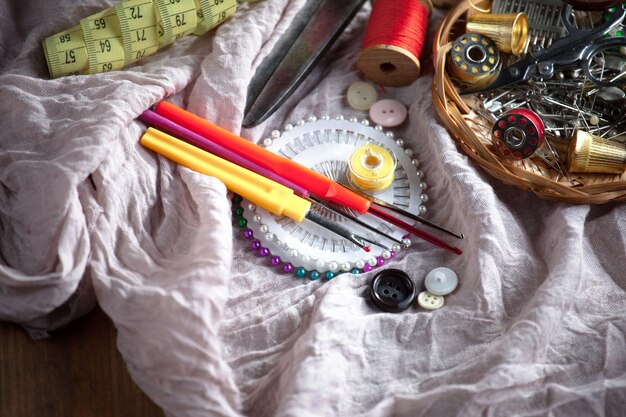
Must-Have Tools
Having the right tools on hand makes it easier to reimagine and reshape clothing. These tools enable precision and ease when altering thrift store treasures. The tools provide a professional finish to your creations.
- Sewing machine: For more complex alterations and constructions.
- Hand sewing needles and thread: For mending and detailed work.
- Scissors and seam ripper: For deconstructing and cutting fabric.
It is important to note that these tools are essential for a successful thrift store flipping project. Proper preparation with the correct tools ensures efficiency and precision in the transformation process.
The correct tools can simplify the process, while the right skills will help you realize your creative vision.
Designing for the Flip: Inspiration and Planning
Before altering any piece of clothing, it’s crucial to have a clear plan. Consider what look or style you would like to achieve through the thrift flip. Inspiration and planning prevent hasty decisions and guarantee a satisfying result.
The planning process allows for creativity and practicality to meet. By examining the garment and considering design possibilities, you can turn overlooked items into unique fashion pieces.
Finding Inspiration
Inspiration can come from a variety of sources. Observing current trends, browsing social media, and studying runway fashion can give you ideas for creating modern and stylish looks. Look at various styles to inspire your project.
Don’t limit yourself to copying existing styles. Use them as a starting point, and then add your own unique twist. This will allow your creativity to flow and result in truly one-of-a-kind pieces.
Sketching and Planning
Once you’ve found your inspiration, it’s time to sketch out your design. This doesn’t need to be perfect, but it helps you visualize the final product. Consider things like length, fit, and any embellishments you’d like to add.
Sketching helps to explore the garment’s potential and plan the steps needed to reach the desired outcome. A clear plan ensures the project is fun, focused, and efficient.
Simple Alterations, Major Impact
Sometimes, the most significant transformations come from the simplest changes. Basic alterations can breathe new life into thrifted clothing and adjust the fit to provide a more contemporary feel. These simple tactics can change your look.
These adjustments show how small alterations can significantly improve a garment’s overall appearance, making it more modern and wearable. These minor changes can dramatically change your style.
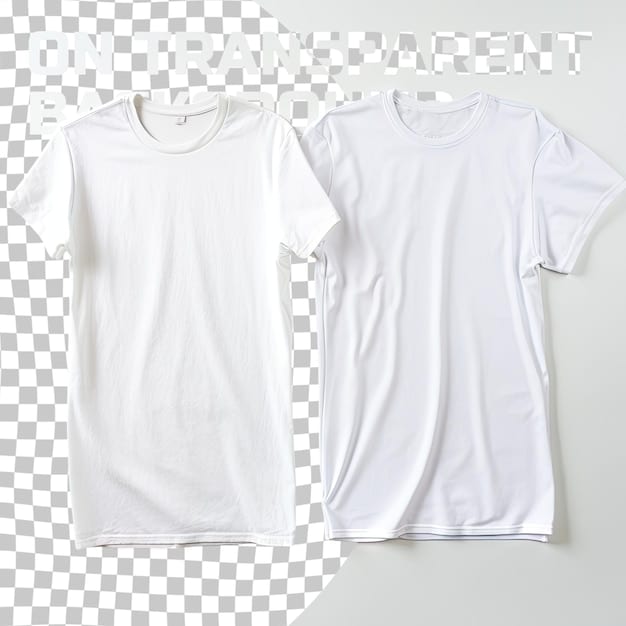
Hemming and Cropping
Adjusting the length of a garment can dramatically change its silhouette. Hemming pants or a skirt can make them more modern and flattering. Cropping a top can transform it into a trendy piece. Experiment with different lengths to find what works best for your body type and style.
Hemming and cropping are fundamental techniques. These provide endless possibilities for updating clothes to your exact style and height needs.
Adding Embellishments
Give your thrifted finds a unique touch by adding embellishments. Patches, beads, sequins, and embroidery can transform a plain piece into a statement item. Get creative with placement and design to reflect your personal style.
- Sew on patches to cover stains or add personality.
- Add beads or sequins for a touch of glamour.
- Use embroidery to create custom designs.
These embellishments allow for creative expression and give character to your altered clothing. By selecting embellishments that resonate with your personal taste, you can create pieces that stand out and reflect your individuality.
With a minimal effort and the addition of these additions, the entire look and feel of an outfit may be updated.
Styling Your Thrifted Creations
The final step in thrift store flipping is styling your newly transformed pieces. How you put together your outfit can make all the difference in creating a high-fashion look. Mixing high and low pieces, playing with accessories, and considering the overall aesthetic can boost your style.
The right styling can make a thrifted outfit look expensive and intentional. It’s about elevating your creations beyond their humble beginnings and showcasing their unique style.
Mixing High and Low
Pairing thrifted items with higher-end pieces can create an interesting dynamic. The contrast between a designer handbag and a thrifted dress, or a tailored blazer and vintage jeans, can elevate the overall look.
The technique of pairing high and low elements is a smart approach to fashion. It makes your closet versatile and shows your fashion-forward attitude.
Accessorizing with Confidence
Accessories can make or break an outfit. Bold jewelry, statement belts, scarves, and hats can add interest and personality to your thrifted creations. Don’t be afraid to experiment and mix different styles.
- Add a statement necklace to a simple dress.
- Cinch a dress with a wide belt to define your waist.
- Tie a scarf around your neck or handbag for a pop of color.
In the world of thrift flipping, knowing how to style a finished product can increase visual appeal. Stylish enhancements can elevate your style.
The best way to style clothes is to think about how to combine items and accessories to create looks that are appropriate for particular situations and that show one’s individual sense of style.
Sustainability and Ethical Fashion
Thrift store flipping: turn secondhand clothes into high-fashion looks for under $50 also supports sustainability and ethical fashion practices. This way to shop creates sustainable fashion options. It also decreases fabric waste in landfills.
Embracing thrifting as a fashion choice promotes environmental awareness and ethical consumption. By lengthening the life cycle of clothing, we can reduce the impact of the fashion industry on the planet. It is a socially conscious choice.
Reducing Waste
By giving new life to secondhand clothes, you’re keeping them out of landfills. Fashion waste is a significant environmental problem, and thrifting is a small but meaningful way to combat it. You contribute to waste reduction by repurposing clothing.
Supporting sustainability through thrifting helps reuse items, thereby reducing waste in landfills. The practice is environmentally and economically sound.
In conclusion, thrift store flipping supports sustainability and responsible consumerism. It is a way to be in style without harming the earth.
| Key Point | Brief Description |
|---|---|
| 💡 Finding Potential | See the potential in thrift store items beyond their current state. |
| 🧵 Alteration Skills | Basic sewing skills can transform your thrift finds into amazing pieces. |
| ✨ Creative Styling | Style your thrifted outfits with confidence to highlight their unique appeal. |
| 🌍 Sustainability | Engage in thrift flipping to support more ethical and sustainable buying habits. |
FAQ
▼
Thrift store flipping is the process of buying clothes (or other items) from thrift stores and reselling them for a profit. Usually, these items are altered or upgraded in some way to increase their appeal and value.
▼
Good places to find inventory include local thrift stores such as Goodwill, Salvation Army, and smaller local charitable organizations. Estate sales and garage sales are also excellent sources.
▼
Look for high-quality materials (silk, leather, wool) and unique vintage pieces that are in good condition. Check for stains, tears, and odors before purchasing. These will be difficult to fix.
▼
Many alterations don’t require advanced sewing skills. Simple hemming, adding embellishments, or changing buttons can significantly improve a garment. Online tutorials can teach you fundamental techniques.
▼
Yes, thrift store flipping can be profitable if done correctly. The keys to success are finding undervalued items, creatively improving them, and selling them at a price point that covers your costs and provides a profit margin.
Conclusion
Thrift store flipping: turn secondhand clothes into high-fashion looks for under $50 is more than just a budget-friendly fashion hack; it’s a creative outlet, a sustainable practice, and a way to express your unique style. By embracing the potential of thrifted finds, honing your alteration skills, and confidently styling your creations, you can achieve high-fashion looks without breaking the bank.

